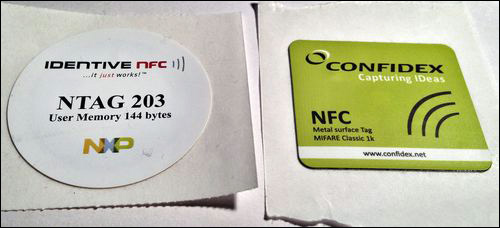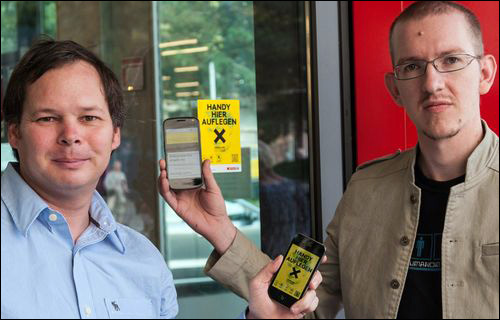Nov 07, 2012A journalist and a software engineer in Austria have joined forces to develop a free plug-in software enabling users to develop applications for reading NFC tags at no charge. The duo first developed the Pingeb.org solution to take advantage of the NFC function in a newly acquired phone, while serving as a virtual library for the town of Klagenfurt. The resulting system is now also being employed to promote local artists.
The idea for the project was conceived on Apr. 13, 2011, recalls Georg Holzer, a freelance newspaper journalist who covers news related to technology, including mobile phones. That was the day that he and a friend, software engineer Bruno Hautzenberger, were looking at Holzer's new NFC-enabled Samsung phone and considering what that NFC technology could be used for. The problem, he says, was that they could find nothing they could do with it in the southern Austria town of Klagenfurt, so they decided to develop a solution. Klagenfurt, with a population of approximately 100,000, lacks a central library, so the two men decided to address that situation by bringing books with local appeal to the town's population. To that end, they accessed books at Project Gutenberg, a Web site that provides free e-books, including transcriptions of works that have fallen out of copyright.
For the use of NFC technology, the partners consulted with Josef Preishuber-Pflügl, the CTO and business unit manager for RFID at CISC Semiconductor, who discussed various details with them, such as which tags would operate best on metal. Initially, they received Identive RFID labels made with NXP Semiconductors' NTAG203 passive 13.56 MHz RFID chips, as a donation from NXP. They found, however, that the Identive labels did not function well when attached to metal poles, so they also acquired Confidex NFC Metal Surface labels made with NXP's Mifare Classic 1K 13.56 MHz passive RFID chips. The RFID labels were attached to large yellow stickers on which they also printed QR codes, along with the words "Handy Hier Auflegen" (German for "Apply Your Mobile Phone Here"). They then attached a total of 70 yellow stickers to poles and other objects throughout the city. Each NFC tag and QR code was encoded with a URL that directs a user's phone to a Web site that then redirects the handset to specific content, such as a book.
Project Ingeborg was named after Ingeborg Bachmann, a Klagenfurt author, and its launch coincided with the city's Bachmann Prize event, also known as the Festival of German-Language Literature. Holzer and Hautzenberger placed the tags on bus-stop poles, lampposts, windows, walls and doorways, which could direct users to books that might relate to the section of the city in which particular tags were located. For example, the tag that takes a user's phone to Der Mörder (The Murderer), a novella written by Arthur Schnitzler, was placed near the city's police station.
Project Ingeborg proved to be very popular, Holzer reports. The stickers received heavy use, he says, with slightly more people using the sticker's QR code than the NFC tag. Within a month after deploying the stickers, the two friends thought about other ways in which to make the system more relevant locally. They decided to promote local artists—authors and musicians—using the same yellow stickers. On a weekly basis, they change the content to which phones are directed—such as a new installment of a book by a local author, a Web page at which the complete book can be purchased, or the latest song of a local musician, performed on YouTube or SoundCloud.

The system operates using free Internet software provided by WordPress and a Pingeb.org plug-in—a software component that directs an NFC phone to a URL at which specific content can be found. The system enables a user to create NFC stickers for providing content to people equipped with NFC phones. For those who create and deploy their own NFC stickers, Holzer warns: "We recommend [they] make the NFC tags read-only during the process, so people cannot change the URLs to possibly malicious sites." The WordPress software and Pingeb.org plug-in (available as a download from the Project Ingeborg wiki) must be installed on an Internet server that supports PHP or MySQL.
To create one's own Project Ingeborg stickers, a person can utilize an NFC-enabled phone to write URLs onto NFC tags by means of an NFC TagWriter, a free Android application created by NXP. The specific URL should direct the phone to a server that will then direct that phone to a Web page at which the desired content can be accessed. A person could use any Web server to host the URLs, but Pingeb.org can also host the URLs under the pingeb.org umbrella, if requested. A Project Ingeborg participant can download the Maps Marker plug-in at WordPress.org, and use it to set up a Google map of the area where the tags are deployed, as well as indicate the data being read at each location. Participants could then use the WordPress program to access the map—to determine, for example, which geographic areas are yielding the most reads.
The stickers can be used to accomplish other tasks as well, Holzer says. For example, an individual employing the stickers could distribute information about a particular place or business.
"We realized that while this is what we're doing now, there is no reason why others couldn't be doing something like it," Holzer says, adding that he hopes people will use their own creativity to develop something unique. "It doesn't have to be the same thing we've done. And for brainstorming, we recommend you spend a night at the bar with your friends. Wrap your head around it, play with our bits and find cool use cases."
Holzer notes that he and Hautzenberger are motivated not to make money, but simply to share what they've already learned. His goal, he explains, is to see the familiar Pingeb.org stickers in another city, in another part of the world.


